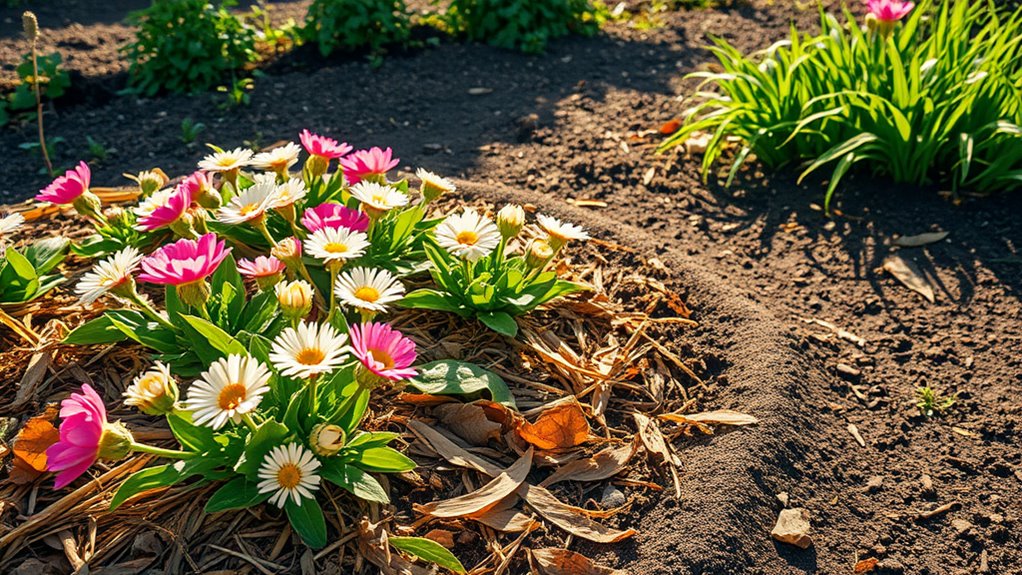This Gardening Habit Saved My Entire Crop Last Summer
You’ll protect your crops just like I did last summer with daily inspections—the simple habit that caught pests early and fended off weather threats. Check leaves and stems for signs, monitor soil moisture, and adjust watering to keep plants resilient. Combine this with natural defenses like companion planting, and you’ll build a thriving garden effortlessly. Stick with these routines, and you’ll uncover even more effective strategies in the tips below.
Key Takeaways
- Daily inspections help detect pests early, allowing for immediate organic treatment to prevent crop loss.
- Regular soil moisture checks ensure deep watering, promoting strong root systems and plant resilience.
- Monitoring weather forecasts enables timely use of row covers and mulching to shield crops from extremes.
- Crop rotation maintains soil fertility and disrupts pest cycles, reducing the risk of infestations.
- Releasing beneficial insects like ladybugs provides natural pest control, safeguarding the entire harvest.
The Habit That Turned the Tide
When pests threatened your garden, adopting a daily inspection habit quickly turned the tide. You spot early signs of infestations by examining leaves, stems, and soil each morning, integrating this into your seasonal gardening tricks.
For spring, focus on aphids; summer targets caterpillars, using tools like magnifying glasses for precision. It’s practical: remove pests manually or apply organic controls immediately, preventing crop loss. Additionally, utilizing natural pest control strategies helps maintain an eco-friendly garden environment.
This technique boosts yields by fostering vigilance, adapting tricks to seasonal cycles for sustained health and productivity in your plot. To enhance this approach, consider incorporating natural herbs as a natural alternative for deterring pests effectively.
Preparing for Unpredictable Weather
Although unpredictable weather can disrupt your garden’s health, you’ll protect your crops effectively by monitoring forecasts daily and implementing simple defenses like row covers or windbreaks to minimize damage and maintain productivity. When preparing, choose defenses tailored to specific threats: row covers block frost, raised beds handle excess rain, and windbreaks counter gusts. For a quick reference, here’s a table of strategies:
| Weather Event | Defense Method | Expected Outcome |
|---|---|---|
| Frost | Row Covers | Prevents freezing damage |
| Heavy Rain | Raised Beds | Reduces waterlogging |
| Strong Winds | Windbreaks | Limits plant instability |
| Drought | Mulching | Enhances moisture retention |
| Hail | Protective Net | Shields against impacts |
Adapt these techniques promptly for robust results. By considering fall planting benefits, you can select crops that are more resilient to weather extremes. These strategies stem from seasonal gardening tricks that safeguarded my crops amid last summer’s challenges.
Essential Daily Monitoring Routines
You’ll check your soil moisture daily using a simple probe or by feeling the soil, ensuring it stays at the optimal level for your plants’ health.
Next, inspect your crops for pests by examining leaves and stems for any unusual spots or insects. By identifying top five pests early, you can implement targeted strategies to protect your plants.
These routines let you address problems quickly and maintain a thriving garden.
Additionally, incorporate natural DIY techniques to effectively manage pests in your garden without any financial outlay.
Monitor Soil Moisture
Monitoring soil moisture daily forms a cornerstone of your gardening routine, ensuring plants thrive without the risks of drought or root rot.
You’ll need simple tools like a moisture meter or your finger to gauge levels accurately—aim for the top few inches to feel for dampness. If it’s dry, water deeply; if soggy, hold off to prevent issues.
Track patterns with a journal, noting variations by weather and plant type. This precision helps you maintain optimal hydration, boosting yield and plant health effortlessly.
Inspect for Pests
Regularly inspecting for pests forms a vital part of your daily garden routine, helping you catch infestations early and protect your crops.
Begin by walking through your garden each morning, examining leaves, stems, and fruits for signs like holes, spots, or webbing. Use a magnifying glass to spot tiny insects such as aphids or mites.
If you detect pests, act quickly: hand-pick them or apply targeted treatments like neem oil. Track your observations in a simple log to identify patterns and adjust methods, ensuring minimal damage and sustained plant health.
Smart Watering and Irrigation Tips
By implementing smart watering techniques, you can optimize your garden’s irrigation to conserve resources and enhance crop health.
Start by using a soil moisture meter to water only when needed, preventing overwatering and root rot. Opt for drip irrigation systems that deliver water directly to plant roots, minimizing evaporation.
Schedule watering early in the morning or late evening to reduce loss from wind and sun. Implement rainwater harvesting for a sustainable source, and apply mulch to retain soil moisture. During extreme heat, these strategies help maintain plant hydration and health under intense conditions.
Regularly calibrate your timers to adjust for seasonal changes, ensuring efficient use. This approach boosts yields while saving water.
Additionally, recognizing common mistakes like overwatering can help prevent issues and promote thriving gardens.
Natural Pest and Disease Defenses
Building on the strong roots from smart watering, you’ll protect your garden from pests and diseases using natural methods that bolster plant resilience. For instance, effective companion planting strategies can enhance garden health and increase crop yields.
These techniques enhance your plants’ defenses without chemicals.
-
Companion planting: Pair repellent herbs like basil with vegetables to deter aphids naturally.
-
Beneficial insects: Release ladybugs to control aphids and mites, maintaining ecological balance.
-
Neem oil application: Spray diluted neem oil on foliage to combat fungal diseases and insects effectively.
-
Crop rotation: Alternate plant families annually to break pest and disease life cycles, promoting vigor.
To maximize these benefits, explore companion planting combinations that enhance growth and promote healthier gardens through scientific principles.
Optimizing Soil Health Practices
While strong roots and natural defenses form the foundation of a thriving garden, optimizing soil health becomes your next key step to ensure nutrient-rich, resilient soil that supports vigorous plant growth. By interpreting results from soil tests, you can identify and address specific soil issues to prevent garden failures.
First, test your soil’s pH and nutrient levels with a reliable kit to pinpoint imbalances. Add organic amendments like compost to enhance microbial life and structure, promoting better water retention. Regular soil testing helps enhance plant health and increase crop yields by addressing potential issues before they impact your garden.
Implement crop rotation and cover crops to maintain fertility and reduce erosion. Aerate compacted areas to improve root penetration, and apply mulch to regulate temperature and suppress weeds, creating an ideal growing environment.
Key Lessons From Last Summer’s Success
You spot early pest detection as a crucial lesson from last summer, where checking your plants regularly helped you act fast and minimize damage.
You establish an optimal watering routine by monitoring soil moisture and watering at the right times, which keeps roots healthy and prevents issues like root rot.
These practices turn your gardening efforts into a reliable success story you can replicate each season.
Early Pest Detection
Detecting pests early last summer transformed my gardening routine, as regular inspections revealed subtle signs like leaf discoloration or unusual insect activity before damage spread.
This habit can protect your crops too, so stay vigilant and proactive in your garden.
Here’s a practical guide to early pest detection:
- Conduct thorough inspections twice a week, checking leaves, stems, and soil for early indicators.
- Use a magnifying glass to spot tiny pests or eggs that might otherwise go unnoticed.
- Document pest sightings in a log, noting patterns to predict and prevent future issues.
- Apply targeted organic controls immediately upon detection to minimize spread effectively.
Optimal Watering Routine
Last summer, fine-tuning my watering routine boosted crop resilience and yields significantly. You must water deeply but infrequently, targeting the root zone to encourage strong growth—you’ll penetrate at least 6 inches of soil per session.
Check moisture levels first; if the top inch feels dry, it’s time to hydrate. Water early mornings to minimize evaporation and disease risk, adjusting volumes based on weather and soil type—sandy soils drain faster, so increase frequency.
Use efficient methods like drip irrigation to conserve water, avoiding overhead sprinkling that promotes rot. This precision prevented drought stress and optimized my harvest.





